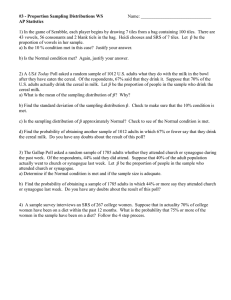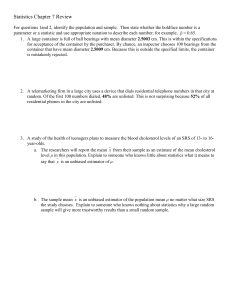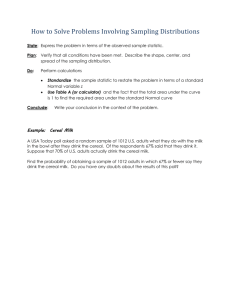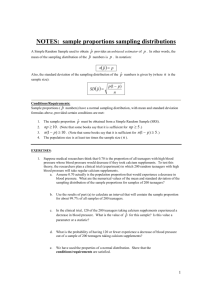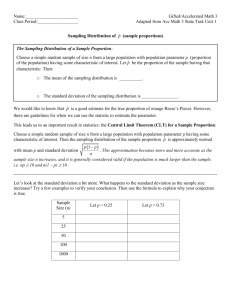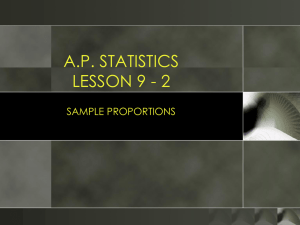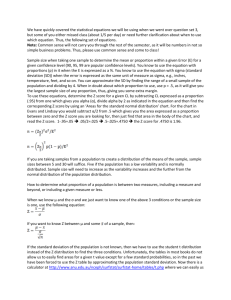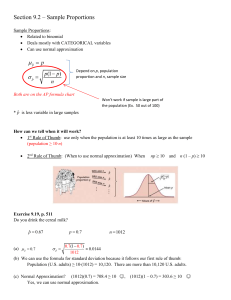Sampling Proportions Homework: Statistics Practice
advertisement
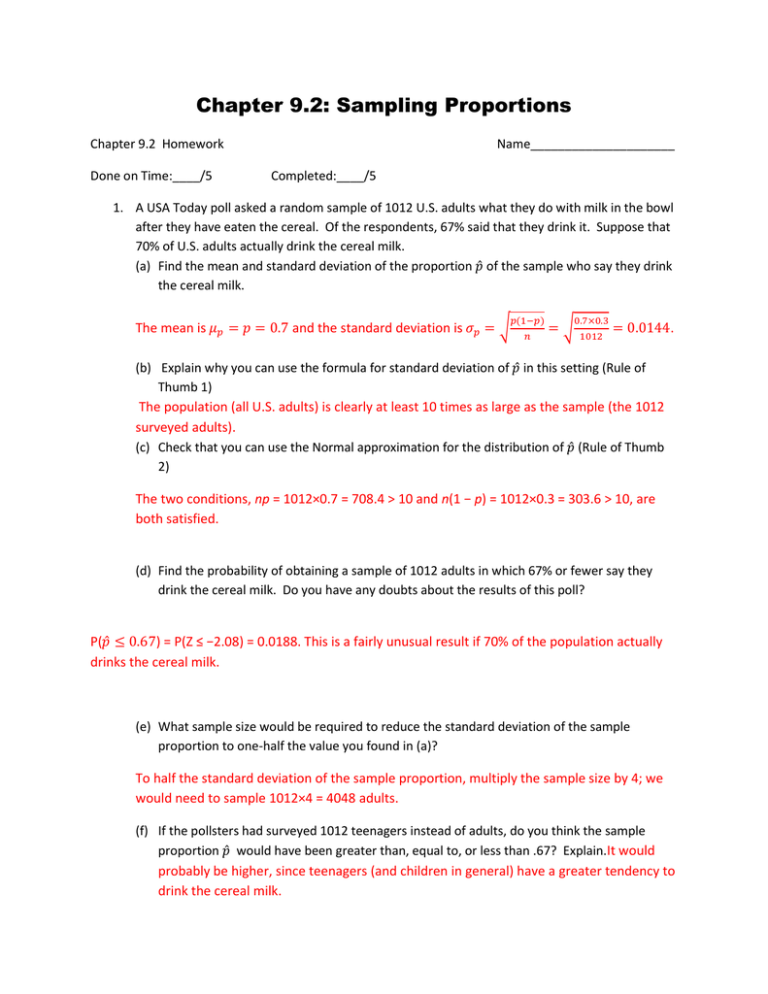
Chapter 9.2: Sampling Proportions Chapter 9.2 Homework Done on Time:____/5 Name_____________________ Completed:____/5 1. A USA Today poll asked a random sample of 1012 U.S. adults what they do with milk in the bowl after they have eaten the cereal. Of the respondents, 67% said that they drink it. Suppose that 70% of U.S. adults actually drink the cereal milk. (a) Find the mean and standard deviation of the proportion 𝑝̂ of the sample who say they drink the cereal milk. The mean is 𝜇𝑝 = 𝑝 = 0.7 and the standard deviation is 𝜎𝑝 = √ 𝑝(1−𝑝) 𝑛 =√ 0.7×0.3 1012 = 0.0144. (b) Explain why you can use the formula for standard deviation of 𝑝̂ in this setting (Rule of Thumb 1) The population (all U.S. adults) is clearly at least 10 times as large as the sample (the 1012 surveyed adults). (c) Check that you can use the Normal approximation for the distribution of 𝑝̂ (Rule of Thumb 2) The two conditions, np = 1012×0.7 = 708.4 > 10 and n(1 − p) = 1012×0.3 = 303.6 > 10, are both satisfied. (d) Find the probability of obtaining a sample of 1012 adults in which 67% or fewer say they drink the cereal milk. Do you have any doubts about the results of this poll? P(𝑝̂ ≤ 0.67) = P(Z ≤ −2.08) = 0.0188. This is a fairly unusual result if 70% of the population actually drinks the cereal milk. (e) What sample size would be required to reduce the standard deviation of the sample proportion to one-half the value you found in (a)? To half the standard deviation of the sample proportion, multiply the sample size by 4; we would need to sample 1012×4 = 4048 adults. (f) If the pollsters had surveyed 1012 teenagers instead of adults, do you think the sample proportion 𝑝̂ would have been greater than, equal to, or less than .67? Explain.It would probably be higher, since teenagers (and children in general) have a greater tendency to drink the cereal milk. 2. The Gallup Poll asked a random sample of 1785 adults whether they attended church during the past week: Suppose that 40% of the adult population did attend. We would like to know the probability that an SRS of size 1785 would come within plus or minus 3 percentage points of this true value. (a) If 𝑝̂ is the proportion of the sample who did attend church, what is the mean of the sampling distribution of 𝑝̂ ? (b) Explain why you can use the formula for the standard deviation of 𝑝̂ in this setting. (c) Check that you can use the Normal approximation for the distribution of 𝑝̂ . (d) Find the probability that 𝑝̂ takes a value between 0.37 and 0.43. Will an SRS of size 1785 usually a result 𝑝̂ within plus or minus 3 percentage points of the true proportion? Explain. 3. Suppose that 40% of the adult population attended church last week. Problem 2 asks the probability that 𝑝̂ from an SRS estimates p = 0.4 within 3 percentage points. Find this probability for SRSs of sizes 300, 1200, and 4800. What general fact do your results illustrate? 4. Harley Davidson motorcycles make up to 14% of all the motorcycles registered in the United States. You plan to interview an SRS of 500 motorcycle owners. (a) What is the approximate distribution of your sample who owns Harleys? Justify your answer. (b) How likely is your sample to contain 20% or more who own Harleys? Do a Normal Probability calculation to answer this question. (c) How likely is your sample to contain at least 15% who own Harleys? Do a Normal probability calculation to answer this question. 5. Your mail-order company advertises that it ships 90% of its orders within three working days. You select an SRS of 100 of the 5000 orders received in the past week for an audit. The audit reveals that 86 of these orders were shipped on time. (a) What is the sample proportion of orders shipped on time? (b) If the company really ships 90% of its orders on time, what is the probability that the proportion in an SRS of 100 orders is as small as the proportion in your sample or smaller? (c) A critic says, “Aha! You claim 90%, but in your sample the on-time percent is lower than that. So the 90% claim is wrong.” Explain in simple language why your probability calculation in (b) shows that the result of the sample does not refute the 90% claim. 6. In an SRS of size n, what is true about the sampling distribution of 𝑝̂ when the sample size n increases? It will be centered around the true proportion p and as n increases, your distribution will look normal and the variance will get smaller and smaller. 7. In an SRS of size n, what is the mean of the sampling distribution of 𝑝̂ ? The mean will be the same as the true proportion p. 8. In an SRS of size n, what is the standard deviation of the sampling distribution of 𝑝̂ ? 𝑝(1 − 𝑝) 𝜎=√ 𝑛 9. What happens to the standard deviation of 𝑝̂ as the sample size n increases? It decreases. 𝑝(1−𝑝) 10. When does the formula √ 𝑛 apply to the standard deviation of 𝑝̂ ? When the population is at least ten times larger than the sample size. 11. When the sample size n is large, the sampling distribution of 𝑝̂ is approximately normal. What test can you use to determine if the sample is large enough to assume that the sampling distribution is approximately normal? 𝑛(𝑝) ≥ 10 𝑎𝑛𝑑 𝑛(1 − 𝑝) ≥ 10

